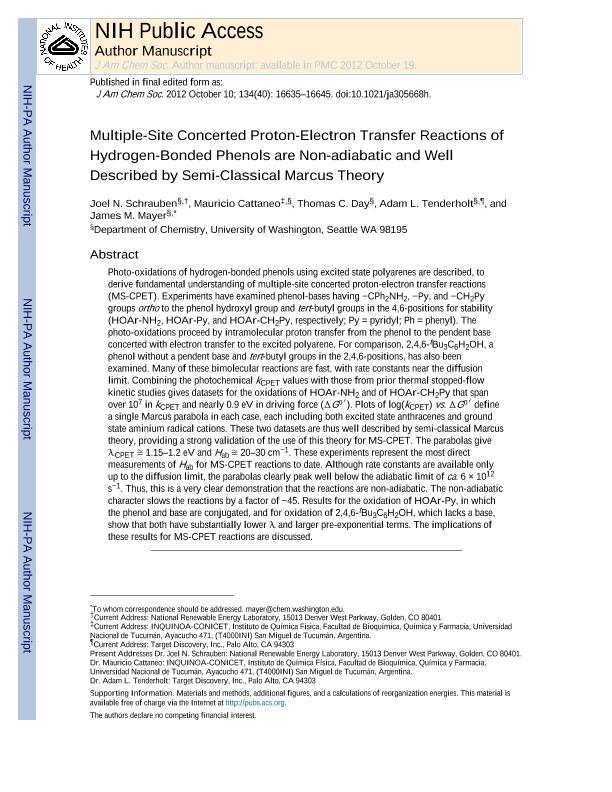Mostrar el registro sencillo del ítem
dc.contributor.author
Schrauben, Joel N.
dc.contributor.author
Cattaneo, Mauricio

dc.contributor.author
Day, Thomas C.
dc.contributor.author
Tenderholt, Adam L.
dc.contributor.author
Mayer, James M.
dc.date.available
2018-07-17T16:49:23Z
dc.date.issued
2012-10
dc.identifier.citation
Schrauben, Joel N.; Cattaneo, Mauricio; Day, Thomas C.; Tenderholt, Adam L.; Mayer, James M.; Multiple-site concerted proton-electron transfer reactions of hydrogen-bonded phenols are nonadiabatic and well described by semiclassical marcus theory; American Chemical Society; Journal of the American Chemical Society; 134; 40; 10-2012; 16635-16645
dc.identifier.issn
0002-7863
dc.identifier.uri
http://hdl.handle.net/11336/52395
dc.description.abstract
Photo-oxidations of hydrogen-bonded phenols using excited-state polyarenes are described to derive fundamental understanding of multiple-site concerted proton-electron transfer reactions (MS-CPET). Experiments have examined phenol bases having -CPh2NH2, -Py, and -CH2Py groups ortho to the phenol hydroxyl group and tert-butyl groups in the 4,6-positions for stability (HOAr-NH2, HOAr-Py, and HOAr-CH2Py, respectively; Py = pyridyl; Ph = phenyl). The photo-oxidations proceed by intramolecular proton transfer from the phenol to the pendent base concerted with electron transfer to the excited polyarene. For comparison, 2,4,6- tBu3C6H2OH, a phenol without a pendent base and tert-butyl groups in the 2,4,6-positions, has also been examined. Many of these bimolecular reactions are fast, with rate constants near the diffusion limit. Combining the photochemical kCPET values with those from prior thermal stopped-flow kinetic studies gives data sets for the oxidations of HOAr-NH2 and HOAr-CH2Py that span over 107 in kCPET and nearly 0.9 eV in driving force (ΔGo′). Plots of log(kCPET) vs ΔG o′, including both excited-state anthracenes and ground state aminium radical cations, define a single Marcus parabola in each case. These two data sets are thus well described by semiclassical Marcus theory, providing a strong validation of the use of this theory for MS-CPET. The parabolas give λCPET 1.15-1.2 eV and Hab 20-30 cm-1. These experiments represent the most direct measurements of Hab for MS-CPET reactions to date. Although rate constants are available only up to the diffusion limit, the parabolas clearly peak well below the adiabatic limit of ca. 6 × 1012 s-1. Thus, this is a very clear demonstration that the reactions are nonadiabatic. The nonadiabatic character slows the reactions by a factor of ∼45. Results for the oxidation of HOAr-Py, in which the phenol and base are conjugated, and for oxidation of 2,4,6-tBu3C6H2OH, which lacks a base, show that both have substantially lower λ and larger pre-exponential terms. The implications of these results for MS-CPET reactions are discussed.
dc.format
application/pdf
dc.language.iso
eng
dc.publisher
American Chemical Society

dc.rights
info:eu-repo/semantics/openAccess
dc.rights.uri
https://creativecommons.org/licenses/by-nc-sa/2.5/ar/
dc.subject
Electron Transfer
dc.subject
Proton Transfer
dc.subject
Marcus Theory
dc.subject
Pcet
dc.subject.classification
Otras Ciencias Químicas

dc.subject.classification
Ciencias Químicas

dc.subject.classification
CIENCIAS NATURALES Y EXACTAS

dc.title
Multiple-site concerted proton-electron transfer reactions of hydrogen-bonded phenols are nonadiabatic and well described by semiclassical marcus theory
dc.type
info:eu-repo/semantics/article
dc.type
info:ar-repo/semantics/artículo
dc.type
info:eu-repo/semantics/publishedVersion
dc.date.updated
2018-07-11T15:16:30Z
dc.journal.volume
134
dc.journal.number
40
dc.journal.pagination
16635-16645
dc.journal.pais
Estados Unidos

dc.journal.ciudad
Washington DC
dc.description.fil
Fil: Schrauben, Joel N.. University of Washington; Estados Unidos. National Renewable Energy Laboratory; Estados Unidos
dc.description.fil
Fil: Cattaneo, Mauricio. Consejo Nacional de Investigaciones Científicas y Técnicas. Centro Científico Tecnológico Conicet - Tucumán. Instituto de Química del Noroeste. Universidad Nacional de Tucumán. Facultad de Bioquímica, Química y Farmacia. Instituto de Química del Noroeste; Argentina. University of Washington; Estados Unidos
dc.description.fil
Fil: Day, Thomas C.. University of Washington; Estados Unidos
dc.description.fil
Fil: Tenderholt, Adam L.. University of Washington; Estados Unidos. Target Discovery, Inc.; Estados Unidos
dc.description.fil
Fil: Mayer, James M.. University of Washington; Estados Unidos
dc.journal.title
Journal of the American Chemical Society

dc.relation.alternativeid
info:eu-repo/semantics/altIdentifier/url/https://www.ncbi.nlm.nih.gov/pmc/articles/PMC3476473/
dc.relation.alternativeid
info:eu-repo/semantics/altIdentifier/doi/https://dx.doi.org/10.1021/ja305668h
dc.relation.alternativeid
info:eu-repo/semantics/altIdentifier/url/https://pubs.acs.org/doi/10.1021/ja305668h
Archivos asociados
